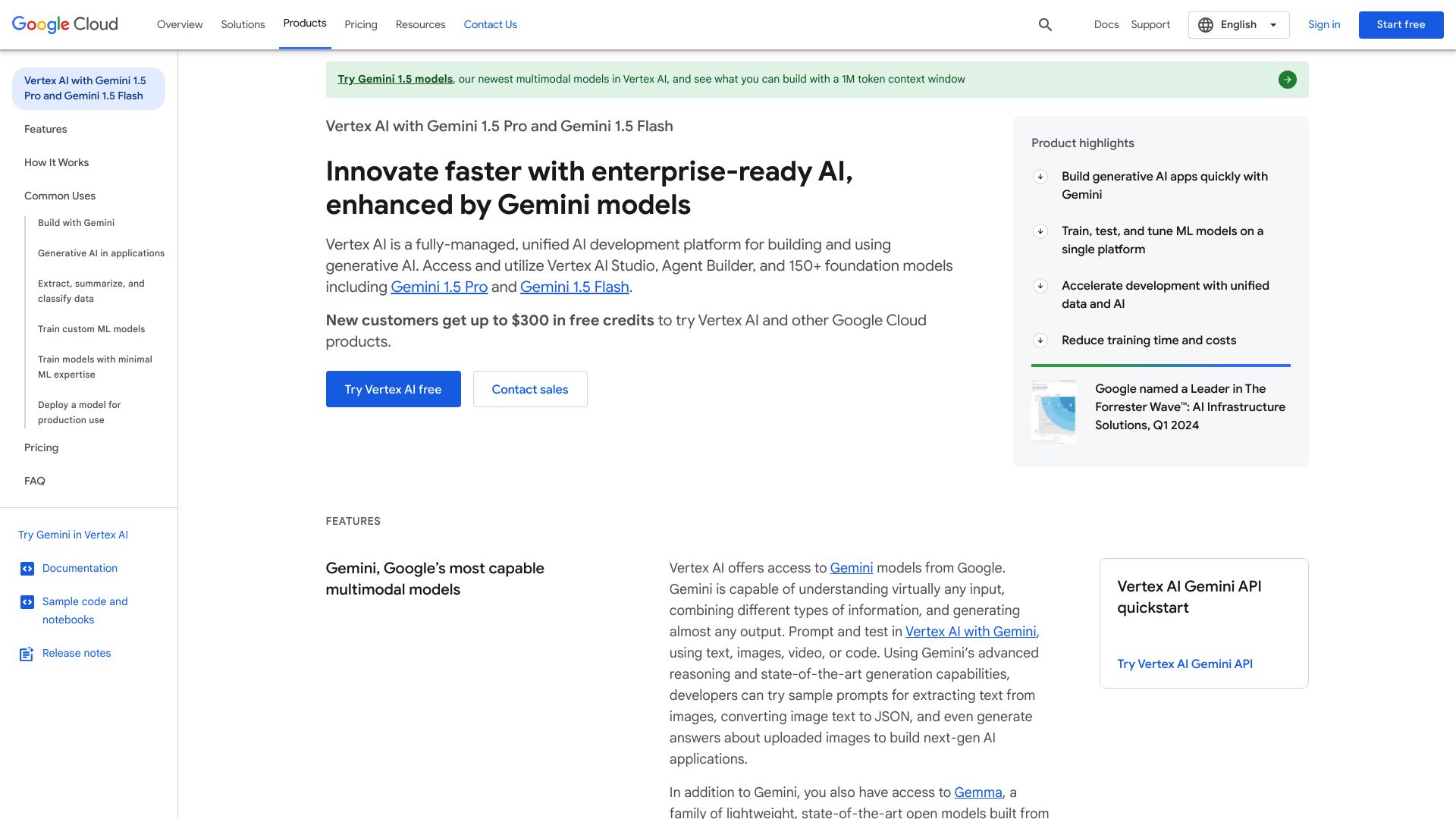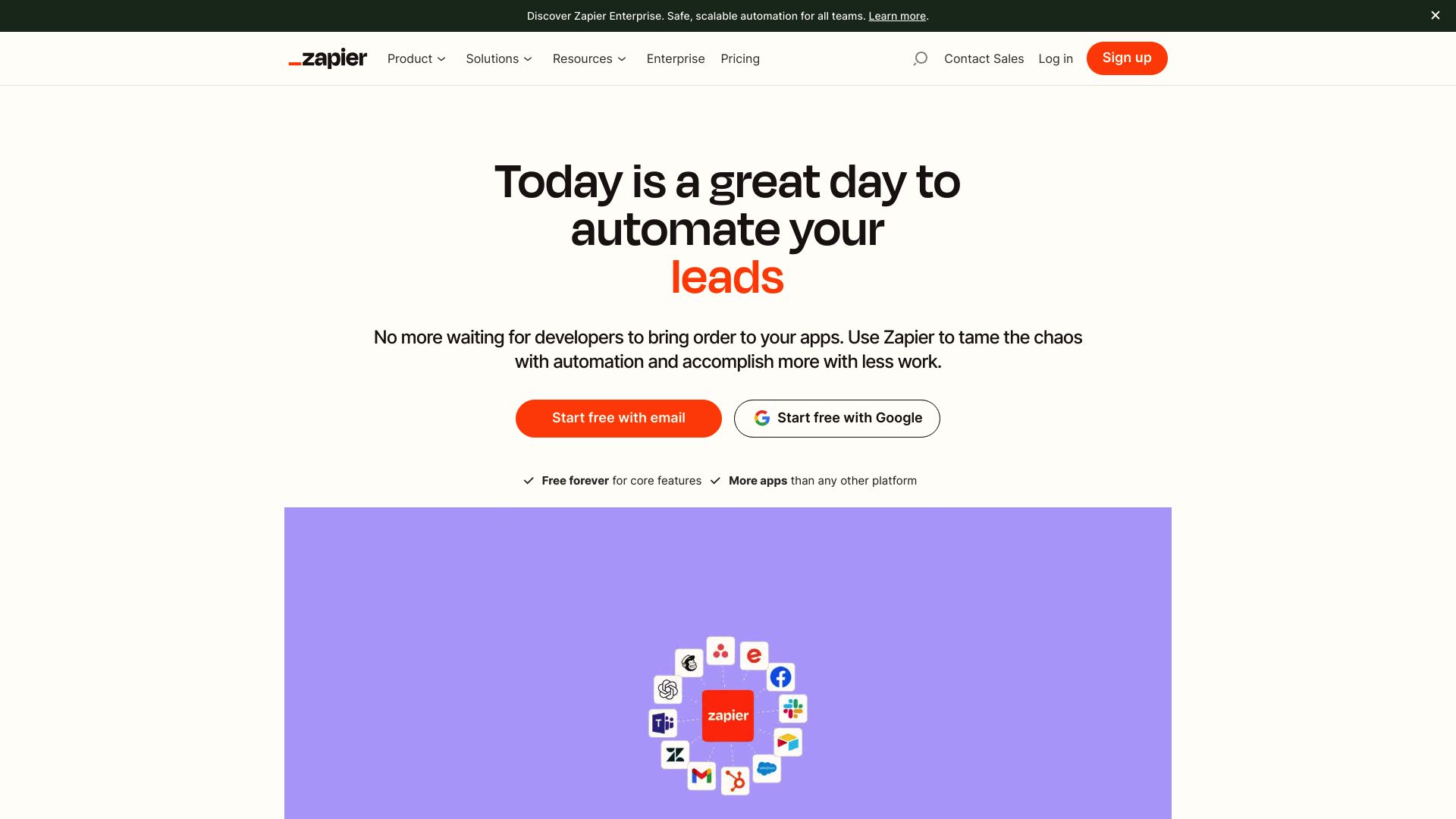Vertex AI vs. Zapier: Key Feature Comparison
AI platforms revolutionize how businesses operate, but choosing the right solution can be challenging. This comparison examines Vertex AI vs. Zapier, and SmythOS, three powerful tools that shape the AI landscape. Vertex AI offers advanced machine learning capabilities for developers and data scientists. Zapier simplifies workflow automation for non-technical users. SmythOS combines AI sophistication with user-friendly design, bridging the gap between complex AI systems and practical business applications. We’ll explore each platform’s strengths, limitations, and ideal use cases to help you make an informed decision for your AI needs.
Vertex AI Overview
Vertex AI empowers organizations to build, deploy, and scale machine learning models and AI applications. This comprehensive platform integrates data engineering, data science, and ML engineering workflows, streamlining the entire AI development process.


Vertex AI’s standout feature, the Gemini multimodal generative AI model, supports text, images, audio, video, and PDF inputs. This versatility enables developers to create sophisticated AI agents capable of advanced reasoning, multiturn chat, and code generation. The platform’s Model Garden offers a diverse library of pre-trained models, including Google’s proprietary offerings and select open-source options, facilitating rapid prototyping and deployment.
Vertex AI’s standout feature, the Gemini multimodal generative AI model, supports text, images, audio, video, and PDF inputs.
The platform excels in model customization, allowing users to fine-tune foundation models for specific use cases. This approach improves cost-efficiency and reduces response latency. Vertex AI also provides robust MLOps tools, including a centralized model registry and feature store, ensuring efficient model management throughout the development lifecycle.
While Vertex AI offers powerful capabilities, it requires coding knowledge for model development and deployment. This limitation may pose challenges for non-technical users seeking to leverage AI technologies. Additionally, the platform’s integration with Google Cloud infrastructure, while beneficial for scalability, may require familiarity with Google’s ecosystem.
Vertex AI’s commitment to responsible AI is evident through features like Explainable AI, which provides feature-based explanations for model decisions. The platform also prioritizes security, offering data encryption and OAuth support. These features, combined with its scalability and integration capabilities, position Vertex AI as a robust solution for enterprises and development teams looking to harness the power of AI in their applications.
Zapier Overview
Zapier connects over 6,000 apps and services, enabling users to automate workflows without coding. The platform streamlines repetitive tasks across popular business tools, saving time and reducing errors.


Users create “Zaps” — automated workflows triggered by specific events. For example, a Zap could automatically add new Salesforce leads to a Google Sheets spreadsheet. Zapier’s visual editor allows non-technical users to build these integrations easily.
Zapier connects over 6,000 apps and services, enabling users to automate workflows without coding. The platform streamlines repetitive tasks across popular business tools, saving time and reducing errors.
While powerful for automation, Zapier lacks true AI agent capabilities. It doesn’t offer natural language processing, machine learning, or autonomous decision-making. The platform excels at connecting existing services but cannot generate new insights or adapt to complex scenarios independently.
Zapier’s strength lies in its vast app ecosystem and user-friendly interface. However, businesses seeking advanced AI solutions for tasks like conversational interfaces or predictive analytics will find Zapier’s capabilities limited. For straightforward automation between popular services, Zapier remains a top choice, but it falls short for more sophisticated AI applications.
Feature Comparison
Vertex AI and Zapier offer distinct approaches to automation and AI integration. Vertex AI provides a comprehensive machine learning platform with advanced AI capabilities, while Zapier excels in workflow automation between apps. Vertex AI supports sophisticated AI model development, deployment, and management. It offers multimodal input processing, including text, images, audio, and video through models like Gemini.
In contrast, Zapier focuses on connecting existing services and automating tasks without true AI capabilities. Vertex AI includes features for model customization, explainable AI, and robust MLOps tools. Zapier lacks these AI-specific features but offers a vast ecosystem of app integrations and a user-friendly interface for creating automated workflows. Vertex AI requires coding knowledge for model development, while Zapier caters to non-technical users with its visual editor. In terms of security, Vertex AI provides data encryption, OAuth support, and IP control. Zapier offers basic security features but may not match the enterprise-level security of Vertex AI. Overall, Vertex AI suits organizations needing advanced AI solutions, while Zapier excels in straightforward automation between popular services.
Feature Comparison Table
| Vertex AI | Zapier | SmythOS | |
|---|---|---|---|
| CORE FEATURES | |||
| AI Agents | ✅ | ❌ | ✅ |
| Hosted Agents (Dev, Production) | ✅ | ❌ | ✅ |
| No-Code Options | ❌ | ✅ | ✅ |
| Memory & Context | ✅ | ❌ | ✅ |
| Autonomous Agents | ✅ | ❌ | ✅ |
| Explainability & Transparency | ✅ | ❌ | ✅ |
| Multimodal | ✅ | ❌ | ✅ |
| Problem-Solving Capabilities | ✅ | ❌ | ✅ |
| Multi-Agent Collaboration | ✅ | ❌ | ✅ |
| Human-AI Interaction | ✅ | ❌ | ✅ |
| Audit Logs for Analytics | ❌ | ✅ | ✅ |
| Agent Work Scheduler | ✅ | ❌ | ✅ |
| SECURITY | |||
| Constrained Alignment | ✅ | ❌ | ✅ |
| IP Control | ✅ | ❌ | ✅ |
| COMPONENTS | |||
| Foundation AIs | ✅ | ❌ | ✅ |
| Huggingface AIs | ❌ | ❌ | ✅ |
| Zapier APIs | ❌ | ✅ | ✅ |
| Classifiers | ✅ | ❌ | ✅ |
| Logic | ✅ | ❌ | ✅ |
| Data Lakes | ✅ | ❌ | ✅ |
| DEPLOYMENT OPTIONS (EMBODIMENTS) | |||
| Deploy as Site Chat | ✅ | ❌ | ✅ |
| Deploy as Scheduled Agent | ✅ | ❌ | ✅ |
| Deploy as GPT | ✅ | ❌ | ✅ |
| DATA LAKE SUPPORT | |||
| Hosted Vector Database | ✅ | ❌ | ✅ |
| Sitemap Crawler | ❌ | ❌ | ✅ |
| YouTube Transcript Crawler | ❌ | ❌ | ✅ |
| URL Crawler | ✅ | ❌ | ✅ |
| PDF Support | ✅ | ❌ | ✅ |
| Word File Support | ✅ | ❌ | ✅ |
| TXT File Support | ✅ | ❌ | ✅ |
Best Alternative to Vertex AI and Zapier
SmythOS emerges as the superior alternative to Vertex AI and Zapier, offering a comprehensive AI automation platform that combines the best of both worlds. We provide an intuitive drag-and-drop interface for creating sophisticated AI agents without extensive coding knowledge. Our platform supports a wide range of AI models and integrations, making it versatile for various use cases.
SmythOS emerges as the superior alternative to Vertex AI and Zapier, offering a comprehensive AI automation platform that combines the best of both worlds.
Unlike Vertex AI’s complex machine learning tools or Zapier’s limited automation capabilities, SmythOS delivers a perfect balance of power and accessibility. We offer autonomous agents that can handle complex tasks, multimodal inputs, and seamless API integrations. Our platform excels in areas where Vertex AI and Zapier fall short, such as no-code options, multi-agent collaboration, and deployment flexibility.
SmythOS stands out with its robust security features, including constrained alignment and IP control, which are crucial for enterprise-level applications. We also provide a hosted vector database and support for various data formats, enabling efficient data management and processing. These capabilities surpass both Vertex AI’s and Zapier’s offerings in terms of comprehensive data handling.
SmythOS stands out with its robust security features… surpass both Vertex AI’s and Zapier’s offerings in terms of comprehensive data handling.
Our platform’s scalability and diverse deployment options, including API, webhook, and scheduled agents, provide unmatched flexibility compared to Vertex AI and Zapier. SmythOS users can easily create and manage AI agents for chatbots, content generation, data analysis, and more, all within a single, user-friendly environment. This versatility, combined with our powerful features and ease of use, makes SmythOS the ideal choice for businesses and developers seeking a truly capable AI agent builder.
Conclusion
Vertex AI, Zapier, and SmythOS each offer unique approaches to automation and AI integration. Vertex AI excels in advanced machine learning capabilities, providing a robust platform for AI model development and deployment. Zapier shines in its simplicity, connecting thousands of apps for straightforward task automation. However, SmythOS emerges as the superior choice, combining the best of both worlds with additional innovative features.
SmythOS stands out with its intuitive drag-and-drop interface, making AI agent creation accessible to both technical and non-technical users. Unlike Vertex AI, which requires coding knowledge, or Zapier, which lacks true AI capabilities, SmythOS enables the rapid development of sophisticated AI workflows without extensive programming skills. Our platform’s support for multimodal inputs, including text, images, and audio, rivals Vertex AI’s capabilities while surpassing Zapier’s limited automation focus.
While Vertex AI and Zapier have their strengths, SmythOS offers unparalleled flexibility and scalability. Our platform supports deployment across various environments, from APIs to chatbots, and even integration with major AI platforms like ChatGPT. This versatility, combined with our extensive integration ecosystem of over 300,000 connections, positions SmythOS as the ideal solution for businesses seeking to harness the full potential of AI without the complexities associated with traditional development platforms.
To experience the power of SmythOS firsthand, we invite you to create a free account and start building AI agents today. With our risk-free trial offering unlimited agent creation for 30 days or 10,000 tasks, you can explore our diverse range of AI-powered agent templates and revolutionize your workflow. Discover how SmythOS can transform your business by deploying AI agents anywhere, efficiently automating tasks, and driving innovation across your organization.
Last updated:
Disclaimer: The information presented in this article is for general informational purposes only and is provided as is. While we strive to keep the content up-to-date and accurate, we make no representations or warranties of any kind, express or implied, about the completeness, accuracy, reliability, suitability, or availability of the information contained in this article.
Any reliance you place on such information is strictly at your own risk. We reserve the right to make additions, deletions, or modifications to the contents of this article at any time without prior notice.
In no event will we be liable for any loss or damage including without limitation, indirect or consequential loss or damage, or any loss or damage whatsoever arising from loss of data, profits, or any other loss not specified herein arising out of, or in connection with, the use of this article.
Despite our best efforts, this article may contain oversights, errors, or omissions. If you notice any inaccuracies or have concerns about the content, please report them through our content feedback form. Your input helps us maintain the quality and reliability of our information.
